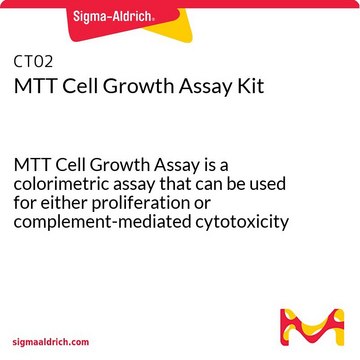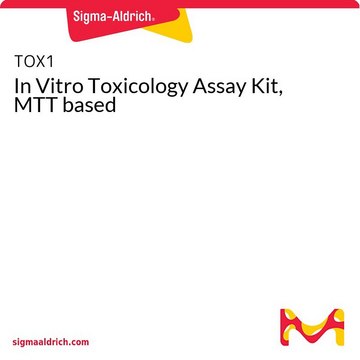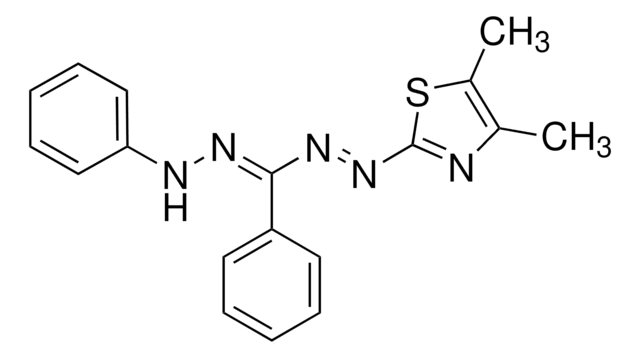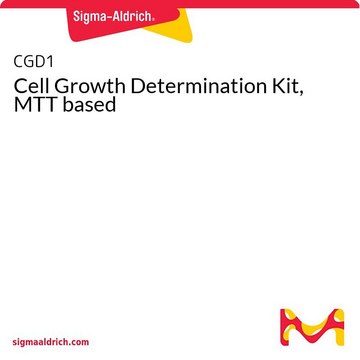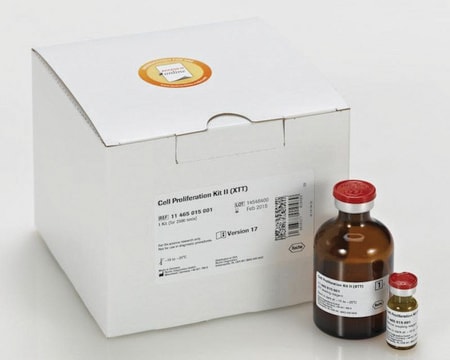CBA410
EZMTT Cell Proliferation Assay, MTT based, 200X
A novel tetrazolium salt based proliferation assay for continous monitoring of growth in mammalian and bacterial cell culture.
About This Item
Recommended Products
detection method
colorimetric
General description
EZMTT is a novel monosulfonated tetrazolium salt, 2-(3-(2-methoxy-4-nitrophenyl)-2-(4-nitrophenyl)-2H-tetrazol-3-ium-5-yl) benzenesulfonate sodium salt (EZMTT). The EZMTT reagents provided high quality and reproducible detection for oxidoreductase enzymes, indicators of cellular metabolic activity. Upon reacting with metabolic enzymes, EZMTT is converted to a yellowish formazan that does not require a solubilization step and can be measured by absorbance at 450 nm. EZMTT assay can continuously track cell proliferation and measure cytotoxicity (loss of viable cells) or cytostatic activity (shift from proliferation to quiescence) of potential medicinal or toxic agents.
Traditional tetrazolium salts, such as MTT, react with NAD(P)H-dependent cellular oxidoreductase enzymes to produce an insoluble formazan, which requires solubilization, has lower sensitivity, and is an end-point assay.
<bold>Features and Benefits of EZMTT:</bold>
• Can be premixed with any media and then directly added to the cells
• Is very stable and has little cytotoxicity. Incubation time depends on the cell number tested, if the color difference in cultures with/without cells is not obvious, a longer incubation from hours to weeks is possible.
• Reduction of EZMTT produces a water-soluble yellow colored formazan dye, which does not require solubilization step
• More sensitive than the traditional MTT assays and can track the cell growth easily (mammalian as well as bacterial cells) by absorbance at 450 nm or color changes. With longer incubation time, as little as 1 bacteria cell can be detected.
• Much less reactive with other antioxidants such as beta-Mercaptoethanol (BME)
Assay Protocol
1. Detach Hela cells and seed different cell number (0, 2500, 5000, 10000, 20000, 30000, 40000, 50000) in each well of 96-well plate with 10% FBS DMEM (100 μl) in triplicates.
2. Incubate at 37?C, 5% CO? for 3-4 hours or overnight.
3. Thaw and Mix 200 X EZMTT cell proliferation assay solution with culture media (20-fold dilution).
4. Add 10 μl of the 10X EZMTT solution to each well of the plate (final 200-fold dilution).
5. Incubate the plate for 1-4 hours in the incubator, measure the absorbance at 450 nm using a microplate reader.
Storage and Stability
Disclaimer
Storage Class Code
10 - Combustible liquids
WGK
WGK 2
Flash Point(F)
188.6 °F
Flash Point(C)
87 °C
Regulatory Listings
Regulatory Listings are mainly provided for chemical products. Only limited information can be provided here for non-chemical products. No entry means none of the components are listed. It is the user’s obligation to ensure the safe and legal use of the product.
FSL
Group 4: Flammable liquids
Type 3 petroleums
Hazardous rank III
Water insoluble liquid
JAN Code
CBA410:
Certificates of Analysis (COA)
Search for Certificates of Analysis (COA) by entering the products Lot/Batch Number. Lot and Batch Numbers can be found on a product’s label following the words ‘Lot’ or ‘Batch’.
Already Own This Product?
Find documentation for the products that you have recently purchased in the Document Library.
Our team of scientists has experience in all areas of research including Life Science, Material Science, Chemical Synthesis, Chromatography, Analytical and many others.
Contact Technical Service
